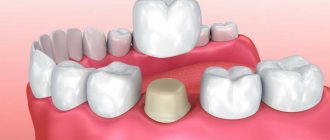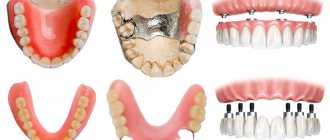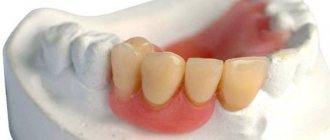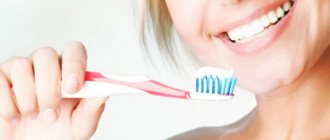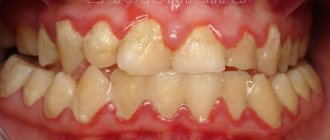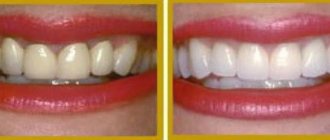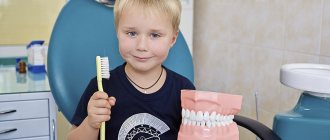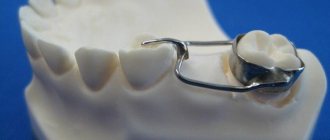2391
One of the methods of orthopedic treatment for loss of natural teeth is prosthetics using a removable structure.
The combination of a removable denture with the remaining natural teeth allows you to restore the dentition, and therefore restore the proper functioning of the jaw mechanism.
Specialized devices are designed taking into account the structural features of the jaw, and involve attachment to natural teeth using clasps.
These elements of the prosthesis allow you to stabilize the prosthesis in the patient’s mouth.
Classification
Clasps are an integral part of the entire removable device system. Their purpose is to hold the prosthesis in the oral cavity, covering part of the body of a natural tooth.
Clasps come in different types and are characterized based on their intended purpose.
Material
The clasp design is made of different materials that differ in functionality:
- fastenings made of medical plastic;
- combined, combining metal and plastic;
- all metal fastenings.
Clasps made of metal are divided into several types:
- alloy of chromium and cobalt;
- alloy of chromium and nickel;
- an alloy of gold and platinum.
The most expensive designs combine noble metals, and at the same time, are the most wear-resistant.
Manufacturing methods
The production of clasps is intended for use only for medical purposes. The manufacturing method depends on the type of product, so they are classified into stamped and bent-cast elements.
This or that type of production is selected for the prosthesis being manufactured and is agreed with the orthopedist.
Functions
In the medical classification, according to their functional characteristics, clasps are divided into the following types:
- restraint devices;
- supporting and holding devices.
The functional purpose is aimed at the correct distribution of load in the oral cavity during the act of chewing.
In addition, such elements are designed to hold the prosthesis in the patient’s mouth.
Form
The designs differ in their shape, which can visually influence the aesthetics of the smile:
- round devices;
- semicircular structures;
- tape
Place of contact
Clasps are distinguished according to the place of contact on the jaw arch during operation of the device:
- gingival;
- dental;
- dentogingival.
Each device is used in accordance with the complexity of the clinical situation and the structure of the patient’s jaw arches.
Tooth Coverage
The element always captures part of the crown of a natural tooth, thus fixing the prosthesis.
Based on the degree of coverage of teeth in the oral cavity, the following types are distinguished:
- single-shoulder and double-shoulder;
- reversible and ring-shaped;
- double and multi-link;
- T-shaped.
The use of each element depends on the condition of the enamel, the size of the dental crowns and the complexity of the clinical situation.
Connection to base
Products have their own classification according to the degree of adhesion to the base zone:
- stable (rigid);
- articular (labile);
- semi-labile (springy).
The installation of systems depends on where the patient’s boundary line is located.
What are silicone dentures and product care?
Come here to take a closer look at the design of the Bredent clasp prosthesis.
At this address https://www.vash-dentist.ru/protezirovanie/semnyie-p/plyusyi-i-minusyi-chastichnogo-plastinochnogo.html we’ll talk about the pros and cons of a removable plate denture with partial absence of teeth.
Complications that may arise due to clasps
Negative consequences or complications associated with prosthesis attachments can occur for various reasons. These include low-quality materials, errors at the manufacturing or installation stage, and non-compliance with operating rules. You may also be allergic to metal or synthetic materials. In patients who already have dentures made of other metals in their mouths, galvanosis often occurs - the sensation of an electrical impulse. Often chips and cracks appear in the enamel, gums bleed and recede, and the necks of the teeth are exposed.
If oral hygiene is unsatisfactory, pieces of food become trapped under the hooks, plaque and tartar form. This provokes caries, periodontitis, causes an unpleasant odor and generally worsens the aesthetics of a smile.
Design features
The design includes the following main elements, which have their own functional features:
- The body is an important link that articulates the constituent elements of the system - the shoulder and the appendix. The part is curved in such a way that it can be conveniently placed on the abutment tooth in the area of contact with the chewing surface of the antagonists.
- The process is an element necessary for complete adhesion of the clasp to the base of the prosthesis. The material is fused into the plastic mass itself, so it is modeled taking into account its resistance to mechanical damage.
- The shoulder is a component whose functional feature is related to the strength and diameter of the tooth girth.
This element should fit snugly, located between the gum space and along the body of the tooth. The shoulder should have good strength and follow the natural anatomical pattern. This guarantees good fixation.
The shoulder itself is also divided into separate functionalities:
- the supporting part prevents any displacement of the prosthesis and maintains the required level of structural rigidity, therefore, when performing the act of chewing, the prosthesis is not subject to deformation;
- Reliability of fixation is guaranteed by the holding part.
There are also support-holding type clasps; their structure, in addition to the body and shoulder, is supplemented with several elements:
- occlusal pad;
- anchor part.
The occlusal pad helps to fix the tooth body from possible displacement in case of a strongly pronounced tubercle zone, and the anchor element is designed to ensure reliable adhesion of the clasp to the metal frame.
Types of clasp structures for partial plate dentures and their manufacturing techniques
One of the important points in removable prosthetics is the fixation of the prosthesis on the jaws and its stabilization. Fixation means strengthening the prosthesis on the jaw, and stabilization means its stability during function. Even in ancient times, wire was used to attach dentures, with the help of which artificial teeth were attached to natural ones. The use of wire in the form of a clasp served as an impetus for the gradual improvement of methods for fixing prostheses. Modern methods of fastening dentures using clasps differ significantly from previously used methods of fastening dentures.
Clasp in German means “hook bracket”. The natural tooth is covered with a metal clasp in the form of a hook, which is connected to the base of the prosthesis and holds it on the jaw.
In the stabilization and fixation of partial plate dentures, the decisive factor is the rational design of the clasps and their correct placement, as well as the presence of well-defined alveolar processes and other anatomical retention points on the jaw. The placement of artificial teeth between the remaining natural teeth also helps stabilize the prosthesis.
The clasps are placed in the prosthesis in such a way that the line connecting them can serve as the axis of rotation of the prosthesis. It is best if this line crosses the denture transversely and passes through the first or second premolars, or crosses the denture diagonally, going from the canine or first premolar of one side to the second molar of the other side.
Before finally deciding on the distribution of clasps, you should carefully examine the supporting teeth. In this case, you need to pay attention to their stability, position in the dental arch, shape and condition of the peri-apical tissues.
Contraindications to using teeth to place clasps are:
- 1) tooth mobility of II and III degrees according to Entin;
- 2) the presence of a pathological process in the area of periapical tissues;
- 3) location of the tooth outside the arch;
- 4) conical shape of the crown (the perimeter of the tooth neck is wider than the chewing surface or cutting edge), low crowns on which the clasp cannot be fixed.
For fixing the clasp, the equator of the tooth - its most convex part - is of great importance; it is used to fix the clasp.
Requirements for clasps.
- 1. The clasp must be made of metal that does not oxidize in the oral cavity.
- 2. The clasp must have springy properties.
- 3. The clasp should not have a flat, but a linear and tight contact with the surface of the tooth. It should be emphasized that the larger the area of contact of the clasp to the tooth, the less the possibility of its precise fit. An inaccurate fit entails the formation of retention points between the clasp and the tooth, in which food debris is retained and conditions are created for the occurrence of a carious process. In addition, tooth enamel is constantly injured by the sharp edges of the clasp.
- 4. The clasp should not injure the mucous membrane of the gingival margin and interdental papillae.
Clasps are divided:
- 1) by function - into holding and restraining-supporting; retainers are designed to hold the prosthesis on the jaw; retainers-supports not only hold the prosthesis, but also prevent it from sinking into the mucous membrane:
- 2) according to the coverage of a tooth or group of teeth - single-armed, double-armed, double-armed, multi-linked and crossover;
- 3) in shape - round, semicircular and flat;
- 4) according to the manufacturing method - bent and cast.
The most rational are bent round clasps made of springy wire with a thickness of 0.8-0.9 mm for the front teeth and premolars and 1.1 mm for molars.
The use of flat clasps is very limited, since it is impossible to accurately fit them to the tooth and obtain the necessary springing effect. Semicircular and flat clasps can only be used in cases where the supporting teeth are covered with metal crowns or when the chewing teeth have very long crowns. They should be made from a well-springing alloy. To stabilize partial plate removable dentures, round wire clasps are most widely used.
The clasp consists of three parts:
- 1) a shoulder covering the abutment tooth from the vestibule of the mouth and located between the equator and the neck of the tooth;
- 2) a body located on the equator from the approximal surface of the tooth; the location of the clasp body closer to the neck of the tooth will prevent the fit of the finished prosthesis;
- 3) a process connecting the clasp to the base of the prosthesis.
The single-arm clasp should be such that the load on the abutment tooth is minimal. For these purposes, the shoulder and body of the clasp are made so that the body of the clasp is a continuation of the shoulder, which covers the tooth from the vestibule of the mouth. This clasp device lengthens the shoulder and thereby enhances its springing effect.
The equator of a tooth can be determined in the following way: the open surfaces of a gypsum tooth, from the neck to its convex part, are filled with hot wax so that these surfaces are parallel. In this case, the most convex part of the tooth—the equator—is clearly visible.
If the laboratory technician is experienced enough, such preparation of the tooth before bending the clasp is not required.
Technique for making a single-arm retaining clasp . The clasp can be bent using special clasp pliers, which have a recess on one cheek and a protrusion on the other. However, round nose pliers and pliers are more often used for this purpose. A piece of springy wire with a length of 2.5 to 3 cm with a diameter of 0.8-0.9 mm for the front teeth and premolars and 1-1.1 mm for molars is bent with forceps at one of the edges - a shoulder is obtained to cover the tooth. The second bend is made with round-nose pliers, as a result of which the body of the clasp is created, and then with the help of two pairs of pliers - round-nose pliers and pliers - a third bend is made to obtain the process. Using round-nose pliers, fix the shape of the clasp near his body, and use pliers to make a bend towards the toothless alveolar ridge. The end of the process, which connects to the base of the prosthesis, should be flattened on the anvil and notches made on it with a file for better connection with the base material (Fig. 19).
Technique for making a double-arm clasp . A double-arm clasp differs from a single-arm clasp in that it has two arms: one arm covers the tooth from the side of the vestibule of the mouth, and the other from the side of the oral cavity. The body of the clasp connects both shoulders.
A double-arm clasp can be made using two methods.
- 1. A single-arm clasp for the outer surface of the tooth is bent from a piece of wire, i.e., having a shoulder, a body and a process, and a single-arm clasp for the inner surface of the tooth is also bent from another piece of wire. When covering a tooth, a clasp with two arms, two bodies and processes is obtained. As a result of connecting them to the base, a two-arm clasp is formed.
- 2. Both arms and the body of the clasp are bent from one piece of wire and an extension is soldered to the body of the clasp to connect to the base of the prosthesis. This clasp has wider applications. Although the method of its manufacture is more complex, it covers the surface of the tooth more accurately.
If the clasp must, in addition to its holding function, serve as a support, a cast supported pad is soldered to the body of the clasp, which is located in a pre-made recess in the tooth.
Techniques for making semicircular and flat clasps . To make a flat clasp, take a metal plate 2-3 cm long and 0.35-0.45 mm thick. The technique for making flat clasps is the same as wire clasps.
Using coronal contour forceps, which to a certain extent manage to create a concavity on the clasp corresponding to the convexity of the tooth on the side of the vestibule of the mouth, bend the arm of the clasp. The remaining bends are made in the same way as when making a round clasp. For better connection with the base, notches are applied to the process with a file.
The manufacturing technique for other types of clasps will be described in the chapter on supported prostheses.
Boundary line
The choice of the required type of clutch depends on the individual structural features of the patient’s jaw apparatus.
The doctor focuses on the location of the boundary line, which is usually presented with five possible options:
- The first type originates in the area of a visible defect in the jaw arch. The location of the line starts from the contact point, runs along the surface and ends in the middle part of the proximal zone of the adjacent tooth.
This arrangement involves the use of two clasp options - Roach and Bonigrad. - The second option involves a smooth extension of the boundary line to the contact point of the adjacent tooth along the vestibular surface from the middle of the proximal surface of the supporting unit.
This arrangement requires a structure that functions as both a support and a holding device. Such a system is the Acker clasp. - The third type involves a diagonal location of the equator on the support unit. The boundary line extends directly from the zone of anomaly of the chewing part of the teeth and tangentially crosses the vestibular surface of the supporting element.
The border of the line ends on the neck of the tooth on the opposite side relative to its beginning. The use of a Ney clasp balances this arrangement. - The fourth option involves an elevated equator zone , which is caused by greater wear of natural teeth.
The pattern is located at the same level with the chewing area, which involves covering the body of the tooth with a crown and protecting it from abrasion. Thus, crowns recreate the natural pattern of the tooth. - The fifth type of location of the boundary line is located in the lower third of the tooth : the equator is located along the neck. This position is typical for patients with cone-shaped natural teeth. In this clinical situation, the use of support structures is typical.
Overview of modifications
Clasps have different functional features and are used in accordance with the individual structural characteristics of the patient’s jaw arches and the current clinical situation.
Support-holding
Support-retaining structures were an improved model of a simple wire hook, fixed directly in the neck area of the support unit.
Through technological developments, support structures have been modernized:
- two types of retaining clasp were designed: alveolar and dentoalveolar;
- The classic system of support-retaining structure is represented by its components: two arms, a process and an occlusal pad.
Ney system
The system can be classified as a standard version of a support-retaining clasp, and the materials are highly wear-resistant during operation. Design features of the Ney system:
- the thickened body and the upper shoulder area are modeled with a sufficient level of rigidity to eliminate frequent fractures directly in the area of articulation with the base;
- the upper part is positioned above a given centerline: this position provides stable support for the frame and creates an obstacle to lateral displacement;
- the lower part is specially thinned and placed below the boundary line, its functionality lies in reliable fixation of the prosthesis, preventing displacement;
- has a wedge-shaped shape: the hard thickened shoulder becomes thinner towards the bottom.
The system is universal, because when fixing there is no need to use a crown for any condition of natural teeth.
The Ney system is designed in such a way that the load on the jaw mechanism is distributed as evenly as possible, without damaging the enamel.
Roach clasps
The use of this type is not possible in all clinical situations, but they are a universal option for anatomically short crowns.
Design Features:
- the design consists of a long rod body and long arms; due to this structure, the element becomes elastic and springs well, which reduces the horizontal load on the teeth;
- rod elements can be used on both sides;
- ensures a highly aesthetic smile.
The Roach model, with all its apparent advantages, cannot be used in case of anatomical violation of the dentition. This also applies to high upper gums that open when smiling.
Acker clasps
This type of model is considered the most effective in its functionality. Acker design features:
- the rigid and durable composition of the system allows it to be fixed to molars;
- the use of the design is justified in the absence of one or two teeth in a row, provided that the supporting units are intact;
- a rigid frame blocks the displacement of clasp dentures;
- practical accessibility.
However, the rigidity and strength of a structure is not always the only guarantee of stability. When using Acker clasps, low elasticity is noted, which limits the possibilities of their use.
Bonneville
The Bonville design guarantees high fixation and stabilization of the prosthesis in the oral cavity, but only if there is sufficient space between the antagonists.
Item Features:
- the design has four arms that perform a holding function, while two of them can also perform a stabilizing function;
- equipped with two occlusal pads, fixed on premolars and molars, prevents food from entering during the act of chewing.
Clasps of this type are used to fix corrective devices for small unilateral anomalies, as well as to preserve elements of the jaw arch on the opposite side.
Jackson
This model belongs to the support-retaining systems of the flip-over type and is visually visible as a kind of loop. Peculiarities:
- placed in the interdental space, encircling the supporting unit, and located below the equator on the vestibular surface;
- support is provided by those parts of the loop that lie in the interdental zone;
- elements responsible for fixation are located below the equator;
- This type of model is available in three options: wire, elastic, and cast.
The Jackson model does not injure the enamel and ensures high stability of the prosthesis in the oral cavity.
Let's find out why the denture rubs and what to do in such a situation.
In this publication you will find useful information about the T Crystal removable denture.
Here https://www.vash-dentist.ru/protezirovanie/semnyie-p/zubnyie-na-prisoskah.html all the most important things about dentures with suction cups.
Ney clasp system:
- Type 1 - Acker clasp;
- Type 2 - Roach double-sided T-clasp;
- Type 3 - combined clasp (Acker-Roach);
- Type 4 - rear (reverse) action clasp;
- Type 5 - ring clasp..
(Figure 5 types of clasps)
Acker's clasp (Ney I).
The Acker clasp consists of an occlusal pad, a body and two arms. In this case, the onlay is located on the occlusal surface of the tooth.
Usage: The most common type of clasp, used in standard situations (when the clasp line divides the tooth roughly)
Roach's Clammer (Ney II)
The clasp consists of 2 T-shaped arms, an occlusal pad, a body and a process
: Used for high clasp lines and deep undercuts. They are also more emthetic because their shoulders are closer to the gums.
Clasp with Acker and Roach shoulders (Ney III).
A combined clasp consists of a rigid arm with an occlusal pad (like an Acker clasp) and a T-shaped arm of a Roach clasp.
Use : The clasp is used on premolars, molars and canines at different levels of the clasp line on the tooth surfaces.
The Roach shoulder, as you remember, is used for large undercut depths.
Reverse action clasp (Ney IV)
It consists of one almost circular arm on which the occlusal pad is located.
Use : It is used more often on the premolars of the lower jaw with the end defect of the dentition.
This is interesting! This clasp is called so because under chewing load the tooth tilts not in the direction of the defect, but back , towards the neighboring tooth. This fact prevents the tooth from tipping over and as a result the tooth is not injured.
Ring clasp (Ney V)
The clasp consists of one (two) occlusal pads, a long arm that almost completely surrounds the tooth, a body and a process.
Usage : Ring clasp is used on single standing molars
Conclusion : I hope you were interested in learning what a clasp is and why it is needed. And also about 5 types of Ney clasp system. These concepts come up more than once in the work of a dentist and understanding them is very important.
I really hope that I have helped you at least a little on your difficult life path. Read other articles, develop, learn new things. Good luck!
Location requirements
Often, the service life of a prosthesis depends on how successfully the clasps are installed during prosthetics:
- The success of the process depends on the anatomical shape of the natural teeth .
The correct shape guarantees good stability. However, installation is also possible in the presence of small defects, which the doctor eliminates before prosthetics. Units with a low conical crown or a heavily exposed neck can be corrected. - The stability of natural teeth is the key to good installation of the structure.
Movable units do not allow the material to be successfully fixed, but the doctor can identify the cause and select the necessary treatment. In addition, sanitation of the oral cavity immediately before prosthetics is mandatory. Caries and minor inflammations also need to be treated. Only after this should we talk about the possibility of installing a prosthesis. - Of great importance is the correct bite , including the correct relationship of the supporting tooth with the antagonists. With a very tight closure, even a small overlay can disrupt the bite, since it is placed in the fissure and disrupts the natural anatomical pattern.
If the jaw arches close too tightly, the specialist installs a protective crown on the supporting tooth. If the clinical situation does not allow the use of such material, then another tooth is selected for support.
How much does prosthetics cost?
The cost of prostheses with hook fixation is the lowest in the segment. For example, a “butterfly” prosthesis can cost from 6,500 rubles, a removable acrylic one from 15 thousand rubles. Much here depends on the length of the orthopedic structure, the type and material of the fastening, the number of clasps, and the base material.
1Glen P. McGeevey Partial Dentures, 2006.
Your questions and answers
QUESTION Hello, tell me, which prosthesis with clasps is better to install? Irina T.
ANSWER Hello, Irina. The choice of prosthesis will depend on the condition and number of supporting teeth, as well as the capabilities of the clinic and the patient’s preferences. With clasps you can make a removable partial denture, acrylic, Acry-free, nylon, acetal, or clasp denture. Better reliability and more compact sizes are found in classic clasp frames, as well as in their modern metal-free counterparts Quattro Ti (“Quadrotti”).
Author: Chernov A. R. (Thank you for your help in writing the article and the information provided)
Manufacturing Basics
Clasps are made by technologists who focus on the prosthesis that will be installed on the patient. The manufacturing technology goes through the following sequence of actions:
- the clasp is essentially a hook that secures the prosthesis, so it is given the desired shape using specialized forceps, round nose pliers or pliers;
- first, a shoulder is formed that covers the dental crown;
- then the body itself is formed.
Dental technicians make the necessary bends to form clasps quickly and accurately, in just a few bends.
Features of the production of the shoulder and contact process
The desired shape of the clasp is formed using round nose pliers. The contact process and the shoulder are formed as separate elements using different tools.
The contact process is first formed with pliers and then flattened on an anvil. This procedure is necessary to apply special notches that promote tight bonding of the process to the base.
A number of rules apply to the manufacture of a shoulder:
- the shoulder must have a sufficient level of elasticity, which is more typical of wire elements than cast ones;
- the shoulder is designed in such a way that its parts lie between the gum and the equator;
- when fixed to an abutment tooth, the material should not cause discomfort;
- the element must adhere to the tooth surface at all points of contact in order to prevent excessive pressure and thinning of the enamel;
- After rounding the shoulder, it must be thoroughly polished to avoid possible trauma to the mucous systems.
The video shows the manufacturing process of Jackson clasps.
Possible consequences
If the manufacturing technology is violated in any way, undesirable consequences for the condition of the oral cavity are possible:
- with horizontal movements of the prosthesis, the material can put excessive pressure on the teeth, which makes them very mobile;
- possible abrasion of the enamel caused by minor damage;
- The clasp can create unfavorable microflora in the oral cavity due to food debris accumulating under it.
In order not to provoke carious infections and the gradual destruction of supporting teeth, the patient should not only thoroughly clean the removable denture, but also consult a doctor at the slightest discomfort.
Side effects from clasps
Denture clasps can cause:
- To the abrasion of the tooth enamel itself due to constant load and micro-movements.
- This leads to a significant deterioration in the hygienic condition of the mouth due to the fact that the clasp is a separate structure and various food debris can accumulate under it. As a result, carious processes begin to develop very quickly. And this destroys the supporting teeth.
- Clasps can cause teeth to become very loose. This happens due to the movements of the prosthesis in a horizontal position. As a result, there is a functional overload of the teeth, which serve as support.
Sources used:
- Kurlyandsky V. Yu. Orthopedic dentistry. — 4th, corrected. - M.: Medicine, 1977.
- Eden SE; Kerr WJS; Brown J. (2002). "A clinical trial of light cure acrylic resin for orthodontic use." Journal of Orthodontics.
- Earls, Stephanie (22 February 2014). "Re-enactor brings George Washington to life." The Washington Times.
- Milward, P.; Katechia, D.; Morgan, M. Z. (November 2013). "Knowledge of removable partial denture wearers on denture hygiene". British Dental Journal.
Reviews
One of the ways to restore chewing functions is prosthetics with removable dentures.
The use of dentures is impossible without supporting and retaining elements that help fix the structure in the oral cavity.
You can share your feedback on the use of dentures with clasps in the comments to this article.
If you find an error, please select a piece of text and press Ctrl+Enter.
Tags prosthetics removable dentures
Did you like the article? stay tuned
Previous article
How long does it take a patient to get dentures?
Next article
Local and general contraindications to the installation of removable dentures

